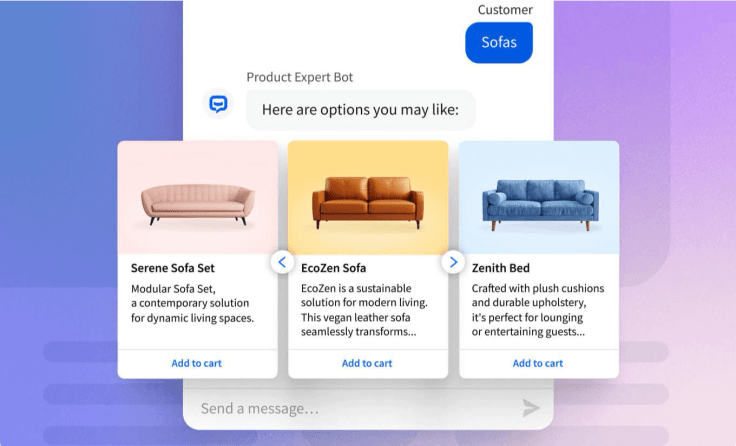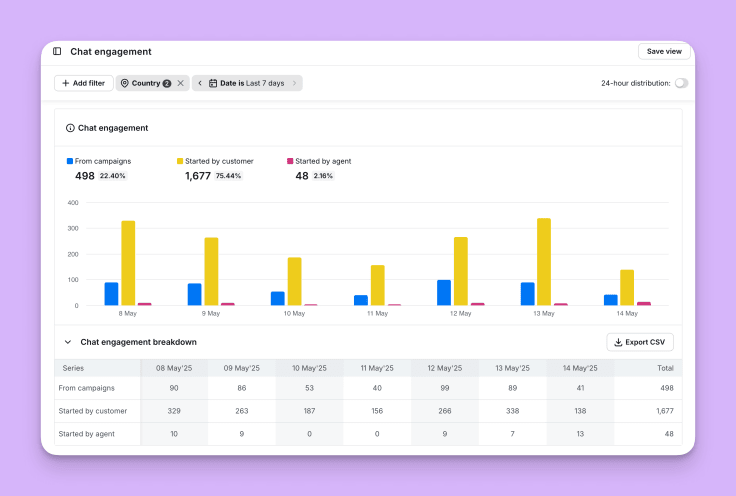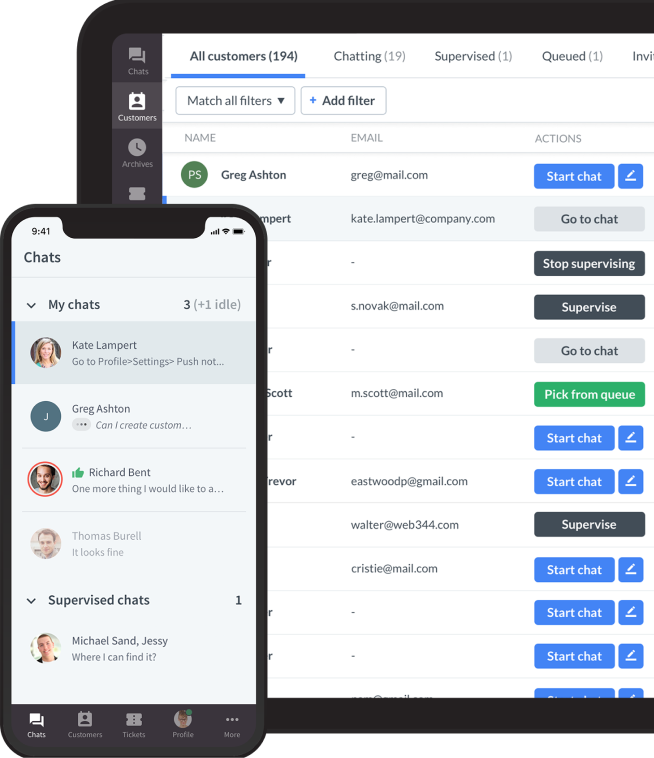
You can have the most feature-rich product on the market. You can run clever ads, offer competitive pricing, and launch on Product Hunt with a bang.
But here’s the thing: if you can’t deliver customer service that meets expectations, nothing will stick.
Because customers don’t stay loyal to brands, they stay loyal to how brands treat them.
That moment when someone’s stuck and reaches out for help? It’s not just a “support ticket.” It’s the moment of truth.
Will you show up with empathy and speed, or send them on a five-day loop through automated replies?
In this article, you’ll learn:
- Why is good customer service one of the biggest drivers of loyalty, retention, and brand growth in 2025?
- How quality support directly shapes the customer experience and influences what they say about you after.
- What makes great service a competitive advantage (even more than pricing or product)?
- The connection between great service, repeat purchases, and long-term revenue.
- How to build a service that not only solves problems, but actually grows your business.
Looking to understand why service truly is your strategy?
Let’s break it down.

Why is customer service important in live chat?
Live chat support is fast, accessible, and often the first place customers turn when they have a question, run into a problem, or need reassurance before hitting “buy.” But here’s the reality: live chat is a strategic and competitive advantage. The way you handle conversations in that little chat box can shape how people feel about your brand, influence their buying decisions, and determine whether they come back or disappear for good.
With customer expectations at an all-time high, slow replies and robotic scripts no longer cut it. People want real-time answers, personalized responses, and a sense that someone on the other end actually cares. And that's exactly what exceptional customer service is like.
And the impact is massive. A recent report shows that 79% of consumers prefer live chat for its immediacy, and 63% are more likely to return to a site that offers it. Even more compelling? Customers who engage in a live chat conversation are significantly more likely to convert, and to spend more when they do.
Customer service is important because great live chat support builds trust, encourages repeat purchases, and reduces churn.
In the sections ahead, we’ll show you how strategic, effective customer service delivered through live chat can directly impact your reputation, loyalty, revenue, and competitive edge.
1. Customer satisfaction builds brand reputation
Customer service is often the first real human touchpoint your customer has with your brand, and it’s almost always the one they remember most. You might have a beautiful website, a fast checkout process, and top-tier marketing. But if your customer service team ghosts someone during a frustrating moment? That’s the story they’ll tell.
Good customer service is personal, and it leaves a lasting emotional impression. And in today’s hyper-connected world, those impressions matter more than ever. People talk. They post reviews. Screenshots of great or poor customer service experiences make their way to X, Reddit, and group chats. In that sense, your customer support team is either your best marketing asset or your most damaging liability.
Exceptional service boosts customers' perceptions of your brand. When customers feel heard and helped, they remember the company behind the kindness. That good feeling stays with them and influences their future perceptions of your business.
More importantly, strong support protects your reputation. One poor experience can spiral into a public complaint or a viral post that damages trust. But a great one? That gets shared just as fast, and often with genuine appreciation.
Of course, the opposite is just as memorable, but for all the wrong reasons. Everyone’s seen screenshots of customer service disasters: the endless email loops, the broken chatbot conversations, or the automated voice saying, “Your call is important to us,” while keeping someone on hold for 45 minutes.
Those stories spread fast, and once a customer has a bad experience, fixing the relationship takes way more time, effort, and cost than it would have taken to just get it right the first time.
Our tip: turn conversations into business intelligence
With LiveChat, you can collect real-time customer feedback using post-chat surveys, star ratings, and CSAT scores, all built right into the chat flow. But you can take it even further.
Enable sentiment tagging and use chat transcripts to spot trends. Are people consistently frustrated after a new feature rollout? Are they confused about your pricing page? These insights can be shared directly with product or marketing teams, with no need for clunky feedback loops.
LiveChat also supports good customer service automation. With integrations like HelpDesk, HubSpot, or ChatBot, you can automate follow-ups, route issues based on topic or sentiment, and even resolve common questions instantly without human intervention.

2. Building customer loyalty is cheaper than acquisition
Ask any growth marketer or business owner what’s more expensive: keeping a current customer or getting a new one.
The answer is always the same: customer acquisition costs more, a lot more. In fact, some studies show it can cost 5 to 7 times more to acquire a new customer than to retain an existing one.
When a customer gets quick, thoughtful help, especially during a stressful moment. It builds trust. Over time, those positive interactions add up and form a relationship. Satisfied customers start choosing your brand not just because of your product but also because of how your team treats them.
Here’s what consistent, great customer service leads to:
- Repeat purchases. Loyal customers buy again and more frequently.
- Higher lifetime value (LTV). They’re more likely to try other products, upgrade, or stick with you through price changes or hiccups.
- Referrals and brand advocacy. Satisfied customers talk. They recommend your brand in Slack, group chats, LinkedIn posts, online reviews, and other customer service channels.
- Lower churn. Outstanding customer service reduces the “I’m done with this” moments that make people cancel or switch to competitors.
Apple is known for building fierce loyalty, not just because of its sleek products but also because of its support system. When something breaks, Apple's live chat agents are fast, informed, and often empowered to resolve things on the spot. That kind of seamless and good customer service makes people feel safe buying again, even if the price is higher than a competitor's.
Now compare that with airlines known for poor customer service when handling customer issues.
One bad experience, a lost bag, a delayed flight, and a customer service agent who shrugs, and that customer may never fly with them again. Worse, they’ll probably tweet about it. A competitor with slightly more effective customer service? That’s where they’ll go next time, no hesitation.
Our tip: keep loyal customers coming back with proactive service
With LiveChat, you can do more than just respond; you can anticipate customer needs and personalize their experience. Here’s how:
- Use chat history and customer profiles to greet returning users by name and reference past conversations, small touches that build connection.
- Set up chat triggers to offer help proactively when a returning visitor seems stuck or hesitant, just like a helpful salesperson in a store.
- Integrate with tools like CRM systems to track customer loyalty, identify VIP customers, and escalate high-value issues to top-tier customer service representatives.
- Install chat widgets on post-purchase or onboarding pages to help existing customers quickly gain more value from your product.

3. Service shapes the entire customer experience
Customer experience (CX) isn’t a single moment; it’s the entire journey a customer takes with your brand. It starts long before they buy anything and continues well after.
While product design, messaging, and marketing all play a role, good customer service is where that experience is either solidified or completely shaken.
A support conversation can feel like a helpful bridge or a brick wall, depending on how it’s handled. That’s why service isn’t just a part of the experience, it often defines it.
Support is how you meet customer expectations
From the very first interaction, customer service plays a crucial role in shaping perception and expectations. Before the purchase, your customer service agents answer pre-sales questions and guide prospects who feel unsure.
During the purchase, it’s the service that steps in when something goes wrong, like a failed checkout or confusing pricing tier.
And after the purchase, when customers need help getting the most out of what they just bought, it’s your support team that either builds loyalty or loses it. At every stage, the quality of service can turn interest into trust, or frustration into churn.
How small moments drive big loyalty
Great customer service is responsive, empathetic, and personal. When a client feels heard and followed up with, customer satisfaction goes up. That satisfaction leads to high customer retention.
But it goes deeper: when agents take time to listen actively, respond quickly, and circle back after a problem is solved, they’re not just closing a ticket, they’re building a relationship. And over time, those relationships form the emotional glue that keeps customers coming back, even if a competitor has a slightly cheaper offer.
Cx and good customer service
It’s important to distinguish CX from customer service. They’re not interchangeable terms. CX is the umbrella, the full experience of interacting with your brand. Effective customer service is one (very visible) pillar underneath it.
But that one pillar often carries more emotional weight than anything else. A delayed delivery or product bug can be forgiven if service is responsive and kind. On the other hand, even the best product loses its shine if help is slow, cold, or unavailable.
Happier customers, stronger teams
A service-driven culture benefits your customers and boosts your internal team as well. When agents are empowered to help and customers respond with appreciation instead of anger, morale goes up. Teams that are valued and supported tend to support customers better in return.
It’s a positive loop: good customer service leads to good experiences, which leads to happier teams, which leads to even better service.
Our tip: connect the dots for a seamless experience
The best way to create a positive customer service experience is by making sure your tools are working together. With LiveChat, you can integrate your support platform with your CRM, marketing tools, and post-sale systems.
This means that when a customer contacts you, your agents already have context, purchase history, past chats, and preferences all in one place.
It shortens resolution time, adds a personal touch, and keeps the conversation consistent across departments. When every team has visibility, new customers never feel like they’re starting over from scratch.

4. Competitive advantage without a pricing war
Most companies fight over features, discounts, and flashy promos. But here's the secret most growth teams eventually learn: you don’t have to win on price or product, you can win on exceptional customer service.
And the more competitive the market gets, the clearer it becomes how important customer service really is to standing out and staying relevant.
Customers today have choices, a lot of them. Do a quick search for any tool or service, and you’ll find pages of options that all sound the same. So when the products feel interchangeable and the pricing is close, what actually sways the decision is how people feel when they interact with your brand.
And that feeling is shaped almost entirely by your customer service.
Exceptional customer service creates trust. Great service builds loyalty. But exceptional service? That becomes your signature, the thing people talk about in reviews, mention on Twitter, or bring up when recommending your company to a friend.
Here’s what excellent customer service actually does in a competitive market:
- It creates emotional stickiness. People remember how they were treated more than what they paid.
- It builds a reputation that outlasts features. Tools change, but values stick.
- It turns your team into your advantage. Competitors can copy your landing page, but they can’t replicate your people.
And unlike growth hacks or discount codes, a service-led advantage only compounds over time. The more you serve your existing customers well, the more they trust you. And the more they trust you, the less likely they are to leave, even when a competitor tries to lure them away.
Picture this: a new customer is comparing your pricing page with a competitor’s. They’re confused about one of your plans and are this close to bouncing. But just then, a proactive chat bubble appears:
"Need help choosing a plan? We’re here."
They click. A helpful rep gives a fast, friendly answer, not just quoting a feature list but understanding what they actually need. In five minutes, you’ve not only kept the customer but also made them feel confident in choosing you.
That’s not sales. That’s service as strategy.
Our tip: win without discounting
With LiveChat, you can turn casual visitors into loyal and satisfied customers by delivering excellent customer service in real time. Here’s how to gain an edge without racing to the bottom on price:
- Use smart routing to instantly direct visitors to the right customer service representatives. Sales questions go to sales, and technical issues go to support. There is no back-and-forth.
- Trigger proactive chats on high-intent pages like pricing, checkout, or comparison blogs. Don’t wait for customers to get stuck; reach out before they leave.
- Customize your chat widget with real agent names, avatars, and a friendly greeting. This will humanize your brand and build trust faster.
- Measure what matters: Track chat-to-conversion rates, customer satisfaction scores, and time to first response.
- Pair with tools like ChatBot to handle common pre-sales questions 24/7, and leave your human team free to handle high-value leads.
The goal isn’t to bombard users, it’s to be there when it matters. A timely, human response does more for your brand than any banner ad or coupon code.

5. Revenue grows with relationships
Revenue spikes can come from a viral campaign or a big promotion, but lasting growth?
That comes from relationships. Businesses that thrive long-term aren’t the ones constantly chasing new leads. They’re the ones who know how to keep the customers they already have. And great customer service is at the core of that. It’s not just a reactive function. It’s an active force for customer retention, upselling, and customer loyalty that fuels sustainable revenue.
A single positive customer service experience can be the moment a customer decides to stick around. Maybe it’s the quick resolution of an issue, or the fact that someone followed up just to make sure everything worked out. These moments build trust.
And when people trust your brand, they buy more often. They’re more likely to try that new product, renew that subscription, or upgrade their plan, because they feel confident they’ll be taken care of if anything goes wrong. Over time, those return visits add up to significantly higher customer lifetime value.
Customers don’t recommend brands because the product is fine. They recommend brands that treat them well, especially when things don’t go perfectly. Good customer service turns customers into fans, and fans talk.
They leave reviews, share recommendations, and defend your brand in comment threads. That kind of word-of-mouth is incredibly valuable because it’s genuine and costs you nothing. One great support interaction can ripple outward into multiple new customers.
Churn isn’t always about product. It’s often about silence. A customer who hits a problem and can’t get a timely or thoughtful response is a customer who’s already checking out a competitor. Even if they don’t leave immediately, their trust erodes.
But when support shows up quickly, solves the issue, and makes them feel like a priority, it’s a reset. They don’t just stay, they become more loyal than before.
That’s why superior customer service should never be seen as a cost; it’s one of your best tools for protecting revenue.
Our tip: turn conversations into conversions
LiveChat gives you the power to make every interaction count, before, during, and after a sale. When connected with your CRM or ecommerce tools, chat becomes more than just support; it becomes a sales engine. You can spot high-value customers, offer tailored recommendations in real time, and recover at-risk users with proactive outreach.
Chat transcripts reveal patterns, giving you insight into what keeps people from converting, or what makes them come back. And when your customer service team is empowered with the right data and tools, they can guide conversations that don't just solve problems, but grow revenue.
Ensure business success with customer loyalty
Every chat, email, and moment of support is an opportunity to deepen the relationship, strengthen customer retention, or damage it entirely.
The brands that win are the ones that see service not as a cost center but as a growth channel. Good customer service doesn’t just support the customer experience; in many cases, it is the experience.
The companies that invest in service now, making it faster, more human, and more integrated, will keep their customers longer, sell more over time, and build reputations no competitor can undercut with features or pricing alone.
If you’re ready to make customer support your superpower, LiveChat has the tools to help you do it right, from proactive customer service and CRM integrations to real-time insights that turn conversations into growth.




